
A new analysis by researchers at the National Energy Research Scientific Computing Center (NERSC) and Lawrence Berkeley National Laboratory (LBNL) projects that quantum computers may shift from a theoretical promise to a practical tool for U.S. Department of Energy (DOE) scientific workloads within the next decade. The study, posted on arXiv, finds that the resources required to solve key scientific problems on quantum machines have dropped, while hardware capabilities from ten quantum computing companies are projected to rise.
The report examined NERSC’s scientific workload, finding that more than half of current compute cycles are consumed by problems in materials science, quantum chemistry, and high-energy physics, domains where quantum computers could be applied. According to the researchers, materials science problems appear closest to reaching “quantum advantage,” while quantum chemistry is noted as a mature testbed. High-energy physics, however, remains the most demanding domain, requiring significant advances in error correction before quantum devices can compete.
The study proposes a new metric, Sustained Quantum System Performance (SQSP), to measure a system’s practical throughput by capturing how many complete scientific workflows a system can run per year. The researchers reviewed public roadmaps from companies spanning superconducting, trapped-ion, and neutral-atom platforms and found projections of exponential scaling over the next decade. The analysis suggests that a convergence between hardware capabilities and scientific needs could occur within five to ten years.
The report notes that execution time will remain a limiting factor even if qubit counts grow as projected. It also cautions that vendor roadmaps are aspirational and some milestones remain unproven. The study’s authors, including Daan Camps, Ermal Rrapaj, Katherine Klymko, and Nicholas J. Wright, emphasize that continued progress in algorithms and error-correction schemes, as well as tight coupling between HPC and quantum computers, will be necessary to unlock the full potential of quantum computing.
Read more about this collaboration in the HPCwire article here, and find the paper on the Office of Scientific and Technical Information (OSTI.gov) website here.
September 20, 2025

